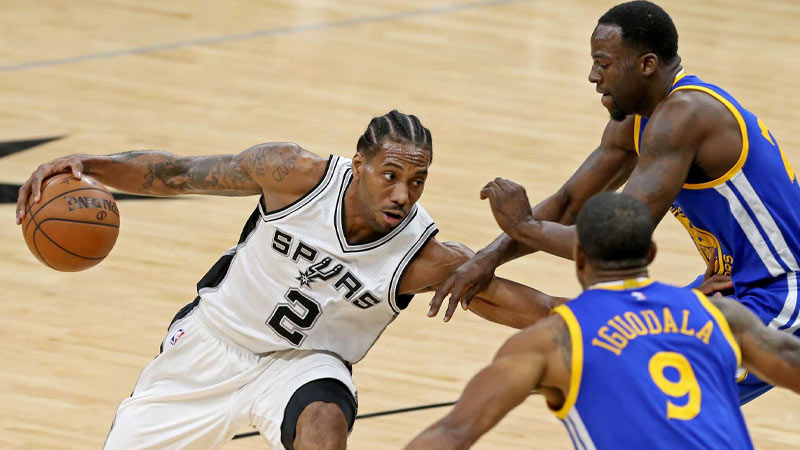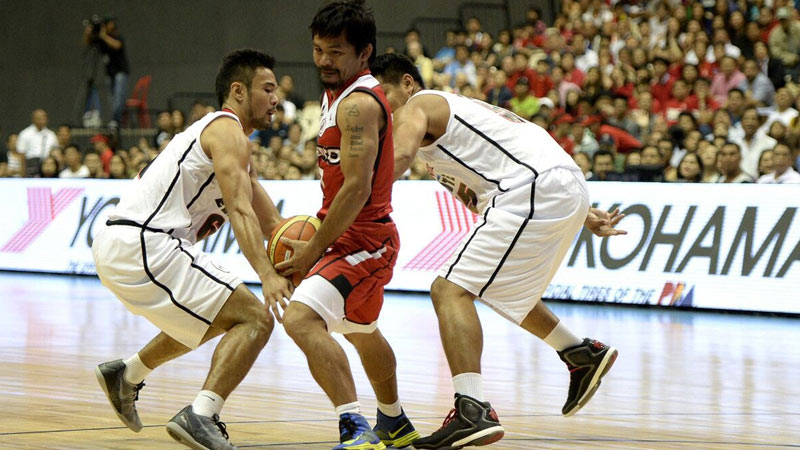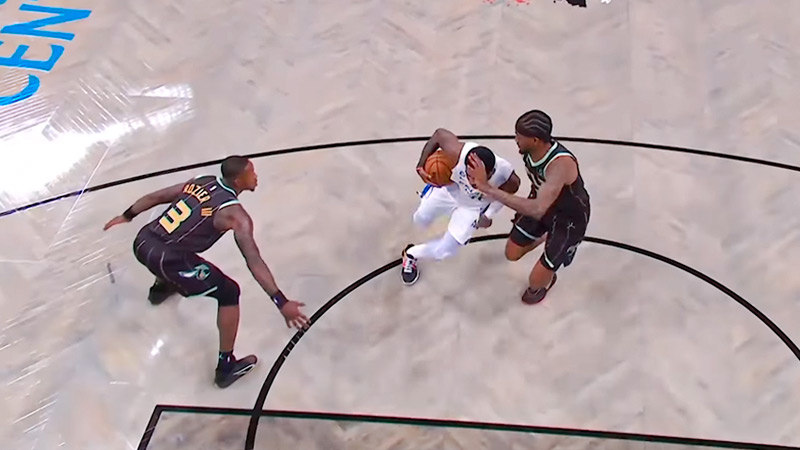In the realm of basketball, defensive strategies play a pivotal role in disrupting opponents’ offensive flow and gaining a competitive edge.
One such strategy is the double team, a tactical maneuver that involves two defenders simultaneously pressuring an offensive player.
In this comprehensive guide, we will explore the intricacies of the double team in basketball, examining its purpose, and when to employ it.
We will also look into how to choose the right situations and the benefits and drawbacks associated with this defensive technique. Stay focused.
What is a Double Team in Basketball?
A double team in basketball is a defensive strategy employed by two defenders to trap and pressure an offensive player. The objective of a double team is to force the offensive player into a difficult situation, limiting their passing options and making it challenging for them to score.
The two defenders work together in a coordinated manner, using their positioning, quickness, and defensive instincts to disrupt the offensive player’s decision-making.
The success of a double team relies on several factors. Communication between the two defenders is crucial to ensure they are on the same page and can effectively coordinate their movements.
Proper positioning is essential, as the defenders must cut off passing angles and prevent the offensive player from escaping the trap. Timing is critical to catching the offensive player off guard or when they are in a vulnerable position.
When Does a Basketball Team Need a Double Team?

Source: expressnews.com
A basketball team may employ a double team in various situations, including:
Guarding Dominant Offensive Players
Double-teaming star players can be an effective strategy to disrupt their offensive rhythm and limit their impact on the game.
By applying intense pressure and denying them space to operate, the double team can force these players into uncomfortable situations, such as taking contested shots or making difficult passes.
This defensive approach aims to frustrate and disrupt the offensive flow of the star player, reducing their scoring efficiency and influence on the game.
Neutralizing Pick-And-Roll Situations
The pick-and-roll is a common offensive play in basketball that often poses challenges for defenses. By double-teaming the ball handler in pick-and-roll scenarios, teams can prevent easy passing or driving opportunities.
The double team disrupts the offensive play by applying pressure on the ball handler, cutting off passing lanes, and forcing them to make rushed decisions.
This defensive strategy aims to negate the advantages created by the pick-and-roll, minimizing the offensive team’s scoring opportunities and forcing turnovers.
Forcing Turnovers
A well-executed double team can create opportunities for steals and turnovers. By trapping the offensive player with the ball, the double team aims to create confusion and pressure, making it difficult for them to pass effectively or find open teammates.
The intense defensive pressure often leads to rushed or errant passes, increasing the likelihood of turnovers.
These turnovers can provide the defensive team with fast-break scoring chances, capitalizing on the disrupted offensive possession.
Employing a double team in these situations requires coordination, communication, and quick rotations among the defenders.
It is essential for the defenders involved in the double team to anticipate and read the offensive actions, ensuring they maintain proper positioning, cut off passing angles, and execute timely traps.
How to Choose a Double Team?

Source: latimes.com
Choosing the right moments to initiate a double team requires a strategic approach, taking into consideration several key factors:
Offensive Player’s Skill Set
Assessing the offensive player’s strengths, weaknesses, and tendencies is crucial in determining whether a double team is necessary or effective.
If the player is a dominant scorer or playmaker who consistently poses a threat, a double team may be warranted.
Conversely, if the offensive player lacks scoring prowess or struggles with decision-making under pressure, a double team may not be necessary.
Defensive Players’ Abilities
Consider the defensive prowess and quickness of the players involved in the double team. The defenders must possess the necessary skill set to effectively trap and pressure the offensive player.
Their ability to anticipate the offensive player’s movements, close passing lanes, and maintain defensive intensity is vital for a successful double team. The defenders should be agile, communicative, and capable of executing quick rotations.
Defensive Positioning
Analyzing the court positioning, spacing, and potential passing options of the offensive player is essential in determining the optimal timing and location for a successful double team.
Evaluating the offensive player’s proximity to the sideline, the presence of additional offensive threats, and potential passing angles help the defensive team anticipate and cut off passing lanes effectively.
By strategically positioning themselves, the defenders can limit the offensive player’s options and increase the likelihood of creating turnovers or contested shots.
Additionally, timing is crucial when choosing a double team. Implementing it too early or too frequently may result in defensive breakdowns and leave other offensive players open for easy scoring opportunities.
The double team should be employed strategically, as a surprise tactic, or during critical moments when disrupting the offensive flow can have a significant impact on the game’s outcome.
Benefits of Taking a Double Team
The benefits of taking a double team are discussed in the following section.
Disruption of Offensive Flow
One of the primary benefits of employing a double team is the disruption it causes to the opponent’s offensive flow.
By trapping and pressuring the offensive player, the double team throws off their rhythm, forcing them into rushed decisions, contested shots, and turnovers.
This disruption can significantly hinder the opponent’s ability to execute their offensive strategies effectively.
Increased Turnovers
The intense pressure applied during a double team often leads to steals and turnovers.
By forcing the offensive player into uncomfortable situations and limiting their passing options, the defensive team can capitalize on these turnovers, gaining additional scoring opportunities in transition.
Increased turnovers can swing the momentum of the game and provide a significant advantage to the team employing the double team.
Defensive Versatility
Utilizing double teams allows teams to be more versatile on defense. It provides the opportunity to apply targeted pressure to specific players or situations, effectively neutralizing key offensive threats.
By adjusting their defensive strategies and applying pressure strategically, teams can disrupt the opponent’s offensive game plan and create defensive advantages.
Drawbacks of a Double Team
Some of the drawbacks of taking a double team are discussed in the following section.
Leaving Other Players Open
One of the drawbacks of a double team is the potential for leaving other offensive players open. When two defenders commit to trapping the ball handler, it opens up passing lanes and scoring opportunities for other offensive players.
Effective defensive rotations and communication are crucial to minimizing the risk of leaving players unguarded and preventing easy scoring opportunities for the opponent.
Defensive Vulnerability
If the offensive player successfully navigates the double team, it can create defensive mismatches and opportunities for open shots or drives to the basket.
If the double team is not executed with precision, the defensive team may find themselves scrambling to recover, potentially leaving the defense vulnerable to exploitation by the opposing team.
Energy Expenditure
Double teaming requires high levels of energy and defensive rotations. The constant movement, rotations, and intensity required to apply pressure on the ball handler can lead to fatigue if sustained for extended periods.
Players must be in top physical condition and maintain a high level of focus to sustain the energy required for effective double-teaming throughout the game.
Despite these drawbacks, the potential benefits of disruption, increased turnovers, and defensive versatility often outweigh the risks associated with double-teaming.
FAQs
When is the right time to use a double team in basketball?
The right time to use a double team depends on various factors, including the offensive player’s skill set, the defensive player’s abilities, and the specific game situation.
It is typically employed to neutralize dominant offensive players or disrupt specific offensive plays.
How can a double team be executed effectively?
Effective execution of a double team requires coordination, communication, and quick rotations.
Defenders must work together to cut off passing lanes, deny open shots, and apply intense pressure on the ball handler while maintaining awareness of other offensive players.
What are the potential risks of double-teaming?
One risk of double-teaming is leaving other offensive players open for easy scoring opportunities.
It also requires defenders to make quick decisions and rotations, which can lead to defensive breakdowns if not executed properly.
How can offensive players counter a double team?
Offensive players can counter a double team by making quick passes to open teammates, creating space through effective ball movement and player motion, or utilizing screens to free themselves or their teammates.
Can a double team be effective against any offensive player?
A double team can be effective against any offensive player, but its effectiveness depends on factors such as the player’s skill set, their ability to handle pressure, and the defensive execution of the double team.
Bottom Line
The double team is a powerful defensive strategy in basketball, providing teams with the ability to disrupt the offensive flow, neutralize star players, and create turnovers.
It requires coordination, communication, and quick rotations to effectively trap and pressure the offensive player.
While the double team offers numerous benefits, such as increased turnovers and defensive versatility, it also carries drawbacks, including leaving other players open and defensive vulnerabilities.
When and how to employ a double team, as well as its potential risks, allows teams to master this defensive technique and gain a competitive edge on the basketball court.







